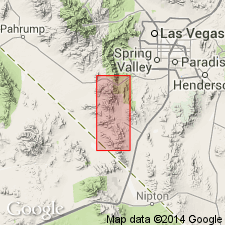
- Usage in publication:
-
- Dawn limestone member*
- Modifications:
-
- Named
- Biostratigraphic dating
- Dominant lithology:
-
- Limestone
- Dolomite
- AAPG geologic province:
-
- Great Basin province
Summary:
Named for exposures near Dawn mine in SW 1/4 sec.15 T23S R58E, Goodsprings quad, Clark Co, NV-San Bernardino Co, CA. Recognizable throughout large part of quad. [no type designated] Included as basal member of Monte Cristo limestone (new). Consists of massive limestone beds from 2 to 10 ft thick; color ranges from light bluish gray to dark smoky gray; texture is porcelain-like or finely crystalline except where unit is altered to dolomite. Total thickness ranges from 60 to 400 ft. Contains many fossils of Early Mississippian age. Underlies Anchor limestone member (new) of Monte Cristo limestone. Overlies Sultan limestone (new). Is considered Early Mississippian age.
Source: GNU records (USGS DDS-6; Menlo GNULEX).
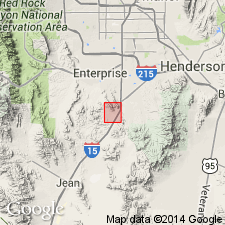
- Usage in publication:
-
- Dawn member
- Modifications:
-
- Areal extent
- Redescribed
- AAPG geologic province:
-
- Great Basin province
Summary:
Mapped in Sloan district, NV, where Dawn member consists of two lithologic units; lower 4/5ths is dull chocolate gray, tan gray, light gray, or white coarsely crystalline dolomite; upper part is thinner bedded (2 to 18 in.), tan-buff medium crystalline dolomite. Underlies Anchor member of Monte Cristo dolomite; contact arbitrarily drawn at base of lowest bed containing chert. Overlies Crystal Pass limestone member of Sultan limestone. Stratigraphic section on Sloan Hill is 175 ft thick. Is Mississippian age.
Source: GNU records (USGS DDS-6; Menlo GNULEX).
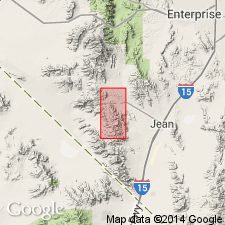
- Usage in publication:
-
- Dawn limestone member*
- Modifications:
-
- Mapped
- AAPG geologic province:
-
- Great Basin province
Summary:
Is structurally and lithologically described with maps and cross sections near each of mines in Yellow Pine district, NV. Maps indicate Mississippian age.
Source: GNU records (USGS DDS-6; Menlo GNULEX).
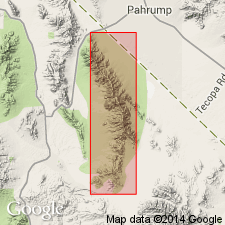
- Usage in publication:
-
- Dawn limestone member*
- Modifications:
-
- Areal extent
- Revised
- AAPG geologic province:
-
- Great Basin province
Summary:
Geographically extended into Nopah Range, Inyo Co, CA where unit is predominantly limestone 350 ft thick. Underlies Anchor limestone member of Monte Cristo limestone. Overlies Crystal Pass member of Sultan limestone. Name Stewart Valley is abandoned, and Mississippian beds previously ascribed to it are assigned to Dawn limestone member. Stratigraphic section shows Mississippian (Osagean) age.
Source: GNU records (USGS DDS-6; Menlo GNULEX).
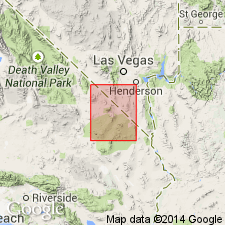
- Usage in publication:
-
- Dawn limestone member*
- Modifications:
-
- Areal extent
- AAPG geologic province:
-
- Great Basin province
Summary:
Dawn limestone member of Monte Cristo limestone is recognized throughout north half of Ivanpah quad and is also present on Old Dad Mountain, San Bernardino Co, CA in southwest corner of quad. Is largely made up of beds of blue-gray to dark-gray limestone, 2 to 10 ft thick but widely altered to dolomite. Age is Early Mississippian, based on fossils identified by G.H. Girty in 1928.
Source: GNU records (USGS DDS-6; Menlo GNULEX).
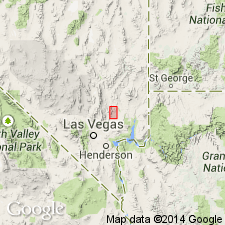
- Usage in publication:
-
- Dawn Limestone
- Modifications:
-
- Revised
- Areal extent
- AAPG geologic province:
-
- Great Basin province
Summary:
Dawn Limestone Member of Hewett (1931) raised in rank to Dawn Limestone of Monte Cristo Group in Arrow Canyon Range and Muddy Mountains, NV. Consists of medium-grained, black, crinoidal limestone in dark gray to black-weathering beds as much as 2 ft thick. Is 196 ft thick at Hidden Valley, 150 ft thick at Battleship Wash and 180 ft thick at Bitter Spring Gap in Muddy Mountains. Contains abundant rugose corals and spiriferid brachiopods. Contact with overlying Anchor Limestone is gradational. Composite columnar section shows Mississippian age.
Source: GNU records (USGS DDS-6; Menlo GNULEX).
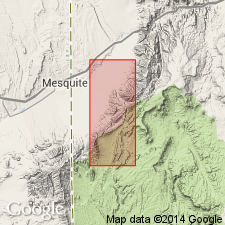
- Usage in publication:
-
- Dawn Member*
- Modifications:
-
- Areal extent
- AAPG geologic province:
-
- Plateau sedimentary province
Summary:
Extended into northwest Mohave Co, AZ, Plateau sedimentary province. [Extended from Muddy and northern Black Mountains, Clark Co, NV]. Is lowermost of five members of Monte Cristo Limestone. Individual members were not separately mapped. Unconformably overlies unnamed limestone unit of Devonian and Mississippian age (probably equivalent to Valentine and part of Crystal Pass Members of Sultan Limestone or parts of Rogers Spring Limestone and is equivalent in part to Temple Butte Limestone). Conformably underlies Anchor Member of Monte Cristo. Age of unit not specified; age of Monte Cristo is Early and Late Mississippian.
Source: GNU records (USGS DDS-6; Denver GNULEX).
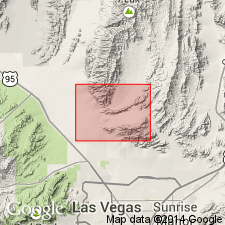
- Usage in publication:
-
- Dawn Limestone Member*
- Modifications:
-
- Areal extent
- AAPG geologic province:
-
- Great Basin province
Summary:
Dawn Limestone Member of the Monte Cristo Limestone is geographically extended into report area. Age is Early Mississippian.
Source: GNU records (USGS DDS-6; Menlo GNULEX).
For more information, please contact Nancy Stamm, Geologic Names Committee Secretary.
Asterisk (*) indicates published by U.S. Geological Survey authors.
"No current usage" (†) implies that a name has been abandoned or has fallen into disuse. Former usage and, if known, replacement name given in parentheses ( ).
Slash (/) indicates name conflicts with nomenclatural guidelines (CSN, 1933; ACSN, 1961, 1970; NACSN, 1983, 2005, 2021). May be explained within brackets ([ ]).

